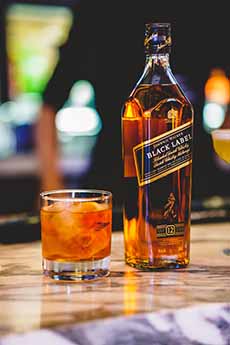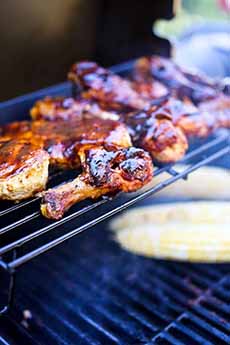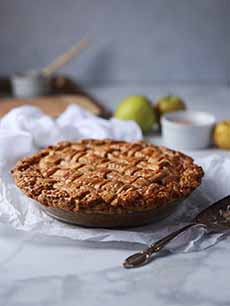TIP OF THE DAY: Cook With Scotch On National Scotch Day
|
July 27th is National Scotch Day. You know how to drink it. How about cooking with it? Although it is much more common to use wine or brandy in cooking, Scotch can offer complex character to everything from appetizers through dessert. Cooking lets you appreciate Scotch—or other whiskey—in new ways. You don’t have to use a “grand cru” Scotch, but don’t cook with the cheapest brand either. You don’t need that much whiskey in any particular recipe, so go for the best flavor. You can put together an entire meal infused with Scotch. If you’re not already aware, most of the alcohol evaporates in the heat of cooking. Recipes that aren’t cooked, such as mousse, need much less alcohol. You also can serve a different Scotch with each course. If you don’t have all that you need, invite guests to bring their favorites. If you prefer a different type of whiskey, use that instead. Omaha Steaks advises: COOKING WITH SCOTCH You can find many recipes with Scotch and other whiskies online, but here’s a menu to start you off. Whisky is the Scottish spelling of whiskey, chosen to differentiate its product from Irish whiskey. The spelling is used by Canada, Japan and Wales as well. In the U.S., a 1968 directive of the Bureau of Alcohol, Tobacco and Firearms specifies “whisky” as the official U.S. spelling, but allows the alternative spelling, “whiskey,” which most U.S. producers prefer. The differences predate modern English, to the sixth century when distillation began in what is now the U.K. Here’s how it began: The Irish are believed to have been the first Europeans to distill whiskey. In Gaelic, the language of the Irish, the name uisge baugh, pronounced ISH-ka BA-ha, was given by Irish monks to the distillate they produced. The monks also called the beverage aqua vitae in Latin. Both phrases mean the same: water of life. A slightly different spelling for the same “water of life” in Celtic, the language of the Scots, and a slightly different pronunciation, ISH-ka BYA-ha. The Gaelic uisge and the Scotch uisce both evolved into usky and then whisky in English. Scholars can’t determine why the “e” was dropped by the Scots. One theory is that the Irish made whiskey first and pronounced it with a broad “e.” When the Scots began to make it, they dropped the “e” to differentiate their product.* In addition, the Irish and Scots disagree over whiskey’s origin. Although it was originally considered little more than a distilled beer (which itself dates to before 5000 B.C.E.), whiskey has evolved into a complex beverage made from different types of mash, the fermented combination of grains that give each whiskey its distinctive taste. Thousands of years later, distillation was discovered in the late 8th century C.E., by an Arab scholar. Known as the Father of Modern Chemistry, Abu Masa Jabir ibn Hayyam (?-803 C.E.) wondered what would happen if he put wine into an al-ambiq, a round vessel like a tea pot with a tall spout on the top, and boiled it. The vapors rose through the spout, were collected and condensed, creating the world’s first distilled alcohol. In fact, since the al-ambiq was often used to boil powdered antimony into a liquid called al-kohl (used to make the cosmetic kohl), the liquid became known as alcohol and the al-ambiq became the alembic still, which remains in use today. The distillate was originally used as medicine and remained a secret process, ultimately shared with the monks in Spain for medicinal purposes. Some orders created their own distillations—liqueurs such as Benedictine and Chartreuse. The Secret Becomes Public Around 1300, Arnald of Villanova, a professor of medicine at one of the first European medical schools, compiled the first hand-written instructions for distillation, calling the alcohol aqua vitae, Latin for “water of life.” This translates into French eau de vie, Scandinavian akavit (now spelled aquavit) and Celtic uisege beatha and the Gaelic uisge baugh. These latter two evolved to usky and then whisky in English. While vodka is not a whiskey†, in Russian and Polish the word is vodka (spelled wodka in POlish) for “dear little water,” instead of “water of life.” Alcohol was believed to prolong life and cure ills. As we now know, whiskey has no curative properties, but it could help people “feel better,” or sleep and forget the pain. English and Irish immigrants to the U.S. began to distill their own whiskeys, including the distillation of corn, which was not grown in the British Isles. Today, whiskey is made around the world, from different grains: barley, corn, rye, and/or wheat. These grains, along with the oak barrels the spirit is aged in, define the taste and aroma of the whiskey. Most whiskeys are made with a blend of these grains, to create texture and depth and fully bring out the best flavor of each grain. Regardless of the type, all whiskey is made from a fermented mash of grain. |
|
|
|
________________ *Source: Perry Luntz, Whiskey & Spirits For Dummies, Wiley Publishing: 2008, p. 62. †Because column distillation results in higher alcohol with fewer compounds that alter the flavor), many column-distilled spirits like vodka and London dry gin aren’t aged, since they lack the components that are likely to change with aging.
|
||









